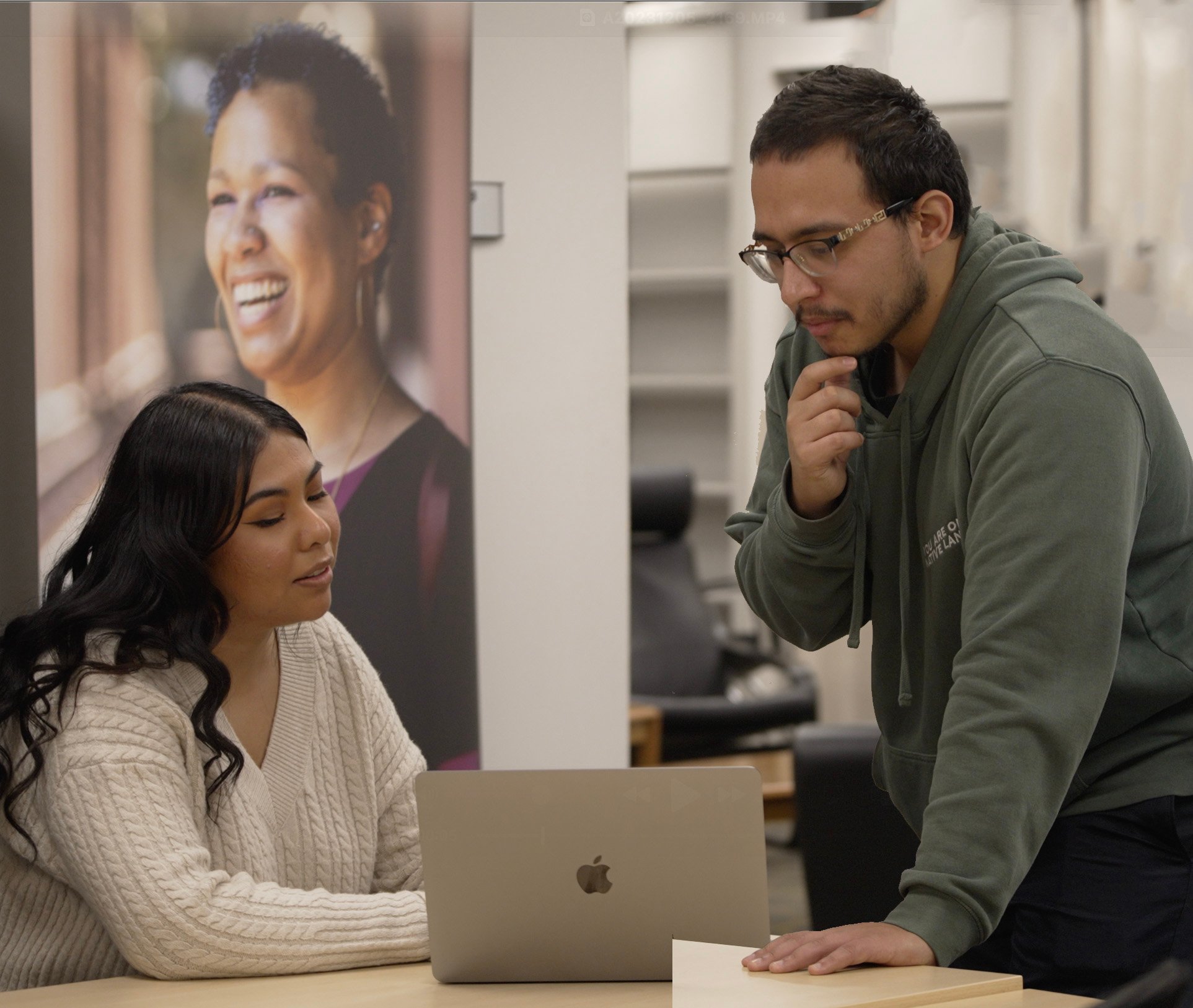
Financial Aid
At Palo Alto University, over 70% of students receive financial aid. With personalized guidance and a wide range of funding options — including scholarships, grants, and loans — your education can be an achievable investment in your future.
Making Education Accessible
Your Guide to Financial Aid at PAU

Invest in Your Future with Personalized Financial Aid Guidance
At Palo Alto University, you’re never alone in navigating financial aid.
Our team is here to guide you one-on-one, helping you explore scholarships, federal loans, grants, and work-study opportunities tailored to your unique situation.
If you’re transferring into a bachelor’s program or pursuing our renowned graduate programs, we’ll support you every step of the way—so you can feel confident and empowered to make the best financial decisions for your future.
Key Deadlines
Free Application for Federal Student Aid (FAFSA) - June 30 of each year for the prior academic year (e.g., June 30, 2026 for the 2025-26 academic year) by midnight CT.
PAU Financial Aid Document Submission: Fall Start Programs July 1st > Spring Start Programs March 15
PAU Scholarship - FAFSA Priority Filing Deadline: January 15 of each year
Cal Grant Priority Deadline (Undergraduates): March 3, 2025
How to Apply for Financial Aid at PAU
Start your financial aid journey in just a few steps.
Step 1 Complete the Free Application for Federal Student Aid (FAFSA)
+The Free Application for Federal Student Aid (FAFSA) is the first step in applying for financial aid to help cover the cost of college. By completing the FAFSA, undergraduate students can qualify for federal grants, Federal Work-Study (FWS), and federal loans, as well as state and school-based aid like the Cal Grant (Undergraduate).
Graduate students must also file the FAFSA to access federal loans and work-study.
Remember that the FAFSA is always FREE. Never pay to apply for financial aid!
PAU’s Federal School Code is 021383. Please ensure that you have added Palo Alto UNIVERSITY to your FAFSA - there is a college in Texas also named Palo Alto, and we want your FAFSA data to come to us here at PAU!
Step 2 Submit the Cal Grant GPA Verification Form (Undergraduates Only)
+Cal Grant – A need-based financial aid program for California residents that provides funding for tuition, fees, and living expenses at eligible colleges and universities. Cal Grants are available only to undergraduate students and do not need to be repaid. For comprehensive information, visit the California Student Aid Commission's Cal Grants page.
- Ensure you meet eligibility for California-specific grants.
- Need help? Watch Cal Grant Video
- Complete the Cal Grant GPA Verification Form (undergraduates only)
- PAU Federal School Code: 021383
Step 3 Receive Your FAFSA Submission Summary (SAR)
+The FAFSA Submission Summary, formerly known as the Student Aid Report (SAR), can tell you about your financial aid eligibility, potential schools, making corrections or changes to your FAFSA form, and next steps as you prepare to receive aid offer letters.
- Your FAFSA Submission Summary will be emailed or mailed after FAFSA processing.
- Review it carefully and correct any errors online. Updates may take up to 2 weeks to process.
- Once the FAFSA is processed by Federal Student Aid (FSA), they will send you an email regarding your FAFSA Submission Summary.
- If an email is not provided on the FAFSA, a paper FAFSA Submission Summary will be mailed to the address provided.
Step 4 Provide Additional Documents (If Requested)
+- PAU will notify you via email if extra documentation is needed.
- Check your student portal and email regularly for updates.
- Submit any required forms or documents promptly.
Step 5 Evaluation Process
+- PAU reviews your application and documents within 1–2 weeks of receipt.
- Stay updated by checking your email and portal frequently.
- Review your award letter via the financial aid portal.
Special Circumstances
If you have special circumstances or a change in circumstances since your original application was filed (such as a parent’s loss of employment, retirement, or change in support of a dependent), you can ask us to review the changed circumstances by submitting a letter defining the situation and providing actual figures. If warranted, we can recalculate your eligibility. Please attach appropriate documentation of the circumstances we are reviewing. Please also note, that if an applicant's FAFSA dependency status changes at any time during the award year, the applicant must update the FAFSA information, except when the update is due to a change in his/ her marital status. Please contact our office for further details and Special Circumstances form.
Step 6 Receive and Accept Your Award Notification
+- Log in to the financial aid portal to accept, modify, or decline your award.
- Complete required forms, such as loan acceptance or those needed for the verification process.
- Funds are disbursed at the start of each quarter.
- Set up direct deposit for faster refunds or pick up checks at the business office
Step 7 Disbursement of Funds
+Financial aid is disbursed at the start of each quarter after confirmation of enrollment. The financial aid funds posted to your account will first be used to cover your tuition and fees. Any remaining balance will be refunded directly to you.
You have the option to enroll in direct deposit by completing the Direct Deposit Form available in the student portal and submitting to the Business Office. Students who do not wish to enroll in direct deposit will have to pick up their paper check from the business office during regular business hours
Step 8 Maintain Financial Aid Eligibility
+- Maintain at least a 2.0 GPA as an undergraduate and 3.0 for graduate students.
- Make sure to update your contact information (mailing address, email, phone numbers) with the University and check your email often.
- Ensure that you meet Satisfactory Academic Progress each quarter and that the classes enrolled count towards your degree program.
- Consult with our office if you have any questions or problems during the quarter.
- Remember to file for financial aid every academic year by the priority deadline of March 2nd.

Complete the FAFSA Today
The Free Application for Federal Student Aid (FAFSA) is the first step in applying for financial aid to help cover the cost of college.
Financial Aid Office Hours
The Financial Aid Team is available Monday-Friday 8am-5pm PST via email at financialaid@paloaltou.edu for quickest response, or leave a voice message at (650)-433-3806 with a call-back number and we will return your call within 28-48 hours.
Contact the Financial Aid Office to schedule an in-person meeting.
>Request an In-Person Appointment:
When: Mondays, 10AM - 6PM PST
When: Thursdays, 9AM–3PM PST
Where: Building 3, Room 306
Financial Aid Live Drop-In Office Hours Via Zoom:
Monday-Friday 10AM-11AM PST or 5PM-6PM PST
Financial Aid Frequently Asked Questions
What is Financial Aid?
+Financial aid is federal, state, institutional or private assistance that comes in the form of grants or scholarships, Federal Work-Study (FWS), and student loans, grants and scholarships do not need to be repaid, while loans must be repaid starting six months after you leave school or fall below half-time enrollment according to your program’s requirements.
How Can I Apply for Financial Aid?
+The first step in applying for state or federal financial aid is to complete the FAFSA application online. Students, parents, and borrowers are required to use an FSA ID to log-in and sign the application.
The FSA ID can be obtained the first time you log into the FAFSA website. The FSA ID is used to confirm your identity when accessing your financial aid information and electronically signing your federal student aid documents.
What Happens After I Apply for Financial Aid?
+After your FAFSA is processed, you will receive a FAFSA Submission Summary via email. This summary details the information that you provided and informs you of any corrections that you need to make.
The financial aid office uses the FAFSA summary information to determine if additional information or documentation is required by the Office of Financial Aid (OFA). You will receive an email from the OFA detailing any additional information that you need to provide to PAU.
What is the Deadline for Applying for Financial Aid?
+The Cal Grant deadline for FAFSA submission is March 2 of each year. PAU has a rolling acceptance for FAFSA filing; however, the earlier you apply and submit all of the required information to the OFA , the earlier you will know what your financial aid package is for the upcoming academic year.
July 1 is PAU’s deadline to submit all your financial aid documents in order for your fall quarter bill to reflect your anticipated financial aid.
PAU Resources Hub
Money Talks
Expert financial guidance through our Money Talks program.
Student Financial Aid Portal Instructions
Please watch the video for a step-by-step guide on using PAUs Financial Aid portal.
Financial Aid YouTube Playlist
Learn More at PAU Financial Aid Playlist on YouTube.
Visit Palo Alto University’s Scholarship Resource Center
Find scholarships to fund your education.
International Resources
We welcome international students to join Palo Alto University’s renowned programs.
Veteran and Military Student Services
Supporting eligible student Veterans, Reservists, National Guard, Active Duty, and dependents with federal education benefits and certification, as well as on and off campus resources that aid in the military to student transition.
Other Financial Aid Resources
Going Merry
A free platform that simplifies the scholarship process by matching students to scholarships and allowing them to apply directly through the site.
Fastweb
A leading scholarship search engine that connects students to relevant scholarships, tracks deadlines, and offers financial aid resources.
Scholarship Institute
A site that reviews and ranks scholarship platforms, guiding students toward the best funding opportunities available.
FinAid!
An all-in-one guide to financial aid, providing insights into scholarships, grants, loans, and savings plans, along with cost estimators.
Go GRAD
A dedicated resource for graduate students, highlighting scholarships, grants, and loan options tailored for postgraduate education.
BestColleges.com
A financial planning hub offering tools, guides, and databases to help students manage college expenses and secure funding.
Sallie Mae
Access over 5 million scholarships through Sallie Mae’s free search tool.
Money Talks: Helping Prepare You for Your Life
Financial Literacy Program at Palo Alto University
Money Talk equips students with the knowledge to make informed financial decisions during their time at Palo Alto University and in their careers beyond graduation.
Learn more from our Introduction Video by Erika Lambert-Shelton, PAU's Financial Literacy and Outreach Coordinator
We want financial literacy to be about your life. We want to focus our resources on providing support and education on financial understanding for all students. The more you know, the better prepared you are because Knowledge is Power. Money talks will provide students with budgeting techniques, different strategies on repaying student loans, saving and investing, importance on credit and credit scores. We will have workshops and webinars on student loan exit counseling, the FAFSA, understanding loan repayment, and financial aid terminology just to name a few.
Supporting International Students at PAU: We welcome international students to join Palo Alto University’s renowned programs.

Connect with Erika Lambert-Shelton, Senior Financial Aid Advisor/Outreach Lead
The Palo Alto University Financial Literacy Team has a commitment to our students to provide them with financial understanding and to advise with proper money management.
Email Erika at elambert@paloaltou.edu or call:
Financial Aid Staff


-1.webp?width=384&height=288&name=Media%20(2)-1.webp)
Need to Contact the Financial Aid Office?
You can contact the Financial Aid Office at financialaid@paloaltou.edu or by phone at 650-433-3824.

